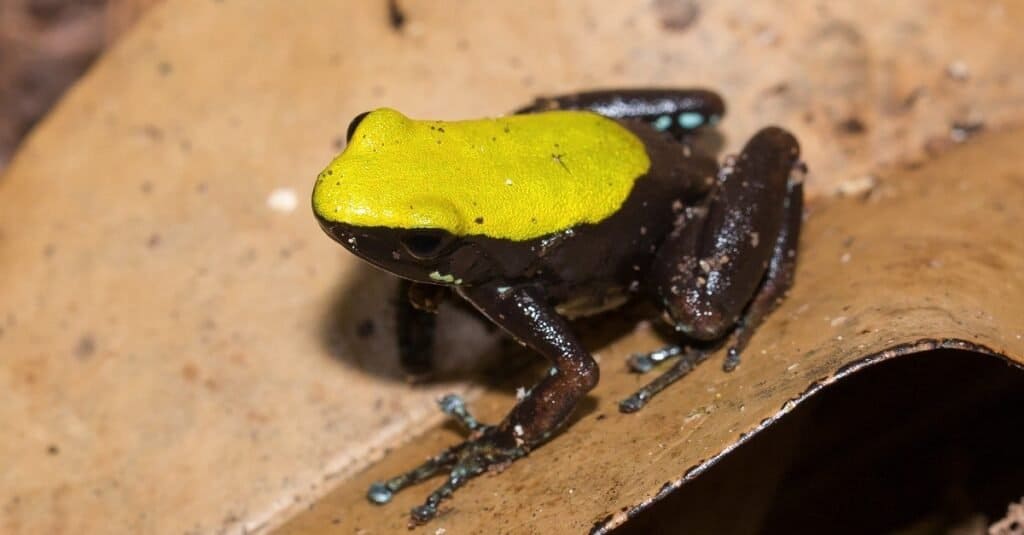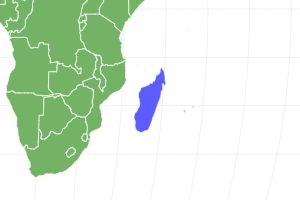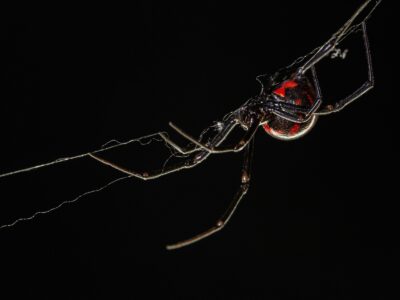Mantella Frog
.jumbotron {
background-image: url(“https://a-z-animals.com/media/2021/10/Mantella-Frog-header-400×300.jpg”);
}
}
@media only screen and (min-width: 641px) and (max-width: 920px) {
.jumbotron {
background-image: url(“https://a-z-animals.com/media/2021/10/Mantella-Frog-header-470×370.jpg”);
}
}
@media only screen and (min-width: 921px) {
.jumbotron {
background-image: url(“https://a-z-animals.com/media/2021/10/Mantella-Frog-header.jpg”);
}
}
Mantella Frog
Some of the smallest and most brightly colored frogs in the world
Mantella Frog Scientific Classification
Read our Complete Guide to Classification of Animals.
Mantella Frog Conservation Status
Mantella Frog Facts
- Prey
- Termites, ants, fruit flies, other insects
- Name Of Young
- tadpoles and froglets
- Group Behavior
-
- Colony
- Fun Fact
- Some of the smallest and most brightly colored frogs in the world
- Estimated Population Size
- unknown, varies by species
- Biggest Threat
- climate change and pollution
- Most Distinctive Feature
- Size and color
- Other Name(s)
- Jewels of Madagascar, Malagasy poison frogs
- Gestation Period
- 2 days
- Litter Size
- dozens
- Habitat
- Island of Madagascar
- Predators
- Small mammals, snakes, birds
- Diet
- Carnivore
- Type
- Amphibian
- Common Name
- Mantella frogs
- Number Of Species
- 16
- Location
- Madagascar
This post may contain affiliate links to our partners like Chewy, Amazon, and others. Purchasing through these helps us further the A-Z Animals mission to educate about the world’s species..

Spiders that fly! Fish that walk! And 1000+ more incredible animals. Discover them all for FREE
.photo-gallery {
–margin: 0px auto 0px;
–padding: 0px 0px 0px 0px;
}
.gallery-link {
background-image: url(“https://a-z-animals.com/media/2021/10/Mantella-Frog-on-leaf-1024×535.jpg”);
background-repeat: no-repeat;
background-size: cover;
background-position: center;
height: 500px;
justify-content: center;
text-align: center;
align-items: center;
display: flex;
border: 2px solid #000;
}
.gallery-link img {
height: 50%;
}
@media only screen and (max-width: 768px) {
.gallery-link {
height: 300px !important;
}
}
View all of the Mantella Frog images!
Mantella frogs are some of the most vibrantly colored, toxic, and tiny frogs in the world.
Mantella frogs are a genus of 16 species, 11 of which are near threatened, vulnerable, endangered, or close to extinct. As a warning to predators, they are vibrantly colored with some having spots or patterns. Because of their colors and size, the frogs are often called the “jewels of Madagascar.” Most mantellas excrete toxins through their skin.
Most other types of frogs are nocturnal, coming out at night and retreating during the day. But because they are so tiny and feature colors that warn off predators, these colorful frogs are active during the day. In many ways, adaptations like being so colorful and visible are keys to their survival.
5 Incredible Mantella Frog Facts!
- Unlike other frogs, mantellas are diurnal
- 11 species out of 16 mantellas are near threatened, vulnerable, endangered or critically endangered
- Most mantella frogs are brightly colored, tiny and toxic
- They are also called the “jewels of Madagascar” and Malagasy poison frogs
- All of the frogs in this genus measure less than 1.22 inches in length
Mantella Frog Scientific name
The Mantella frog makes up the genus Mantella, first named in 1882 by Belgian-British zoologist George Albert Boulenger. These 16 species are part of the family Mantellidae and subfamily Mantellinae. The subfamily currently includes 128 known species but grows in number on an ongoing basis because of new discoveries. The frog genus gets its name from the Italian word mantella that means “cloak.”
Mantella Frog Appearance & Behavior
Most Mantella frogs have brightly colored markings for a very specific reason. Instead of wanting to camouflage themselves on the ground or in trees, they use their skin color to communicate to potential predators that they are toxic and not good to eat. These adaptations them aposematic. Their bright orange, bronze, yellow, blue, or green back markings are also why they are named for the feminine Italian word “cloak.”
Mantella frogs are tiny. They only measure from 0.71in –1.22in (18mm-31mm) and are the second smallest genus of frogs in the world. They are similar in size to the smallest reptile in the world, the Virgin Islands dwarf gecko, and the smallest mammal, Kitti’s hog-nosed bat. Despite being so small, they are diurnal. They come out during the daytime to feed and explore, instead of being nocturnal like most other non-toxic frogs. In fact, they rely on their back colors being seen to keep them safe.
Adult mantellas live in colonies. These colonies are small but have two male frogs for every female. During the breeding season, the males move away to their own territories and become protective of their reign in those spaces, pushing out other males. Females are larger than males.

Artush/Shutterstock.com
Mantella Frog Habitat
Mantella frogs live in the island nation of Madagascar off the coast of Africa and its smaller coastal islands. Within this region, the frogs live in various habitat types. They include primary and secondary rainforests, swamps, wet canyons, semi-arid streambeds, bamboo forests, seasonal streams, forest streams, and grassland savannah.
Some Mantellas have even made adaptations for living in unusual areas. The most adaptable members of the genus are Ebenau’s Mantella (Mantella ebenaui), brown Mantella (Mantella betsileo), and Cowan’s Mantella (Mantella cowanii). Some of these Mantellas have been found living behind human dwellings in trash piles and in regional trash dumps where they feed on flies and ants.
Most mantellas live on the ground. But two, such as the arboreal Mantellas, prefer living in trees. Among the frogs’ adaptations to their habitat include the absence of webbed toes. Mantellas do not have these features because they do not typically swim. They stay among leaves on the jungle floor, frequently climbing over debris like branches. Their legs are shorter in proportion to other frogs’ legs, too. Their short limbs help them climb better. One species, the arboreal Mantellas, have sticky rounded fingertips that help them climb and hang onto trees.
Mantella Frog Predators & Threats
What do mantella frogs eat?
Mantellas eat mostly fruit flies, ants, termites and other insects. From their diet, most frogs in the genus get alkaloid toxins that they use to defend themselves from their own predators. The frogs secrete the toxins through their skin to make a predator sick. These toxins also taste bad to creatures trying to eat them. Together with their brightly colored skin, this bad taste is one of their best survival adaptations.
What eats the mantella frog?
Small mammals, snakes and birds are the primary predators of Mantella frogs. These predators sometimes eat the frogs despite their aposematic colors warning them of the Mantellas’ foul taste and toxicity. In response to an attack, the frog excretes poison through their skin. This poison can make the aggressor sick but will not kill them.
Other threats to Mantella conservation include climate change and habitat loss from farming, agriculture, urban development, logging, and mining. Humans are also predators, targeting the Mantellas as part of the pet trade. Because mantellas absorb water through their skin like all other amphibians, they are highly vulnerable to changes in the environment. In fact, the frog’s population health is a good indicator of the environment’s health.
Reproduction, Babies, and Lifespan
Mantellas breed in spring. During this season, the males leave the colony and claim a territory that they protect from other males. If a male comes into the territory, the owner wrestles him to assert dominance, pushing the invader out.
To start the mating ritual, the male calls out to females using rapid and short clicking sounds. In the first major rainstorm of the mating period, the ground-dwelling female deposits her eggs in short tunnels she creates or among damp leaves. The tree-climbing Mantella deposits eggs in tree holes. Males care for the eggs until they hatch into tiny tadpoles. Gestation is just a few days.
Tadpoles are washed by the rain into nearby pools. There, they feed on algae while they grow for about 6 to 8 weeks into froglets measuring 0.4 inches (11 millimeters) long, equal to the length of a dime. The froglets are not colorful like their parents. Instead, they are a well-camouflaged dull brown for the next several months. Over this period, they slowly transition into adult colors. At a year of age, they become sexually mature.
Mantella Frog Population
According to the IUCN, 11 species of the Mantella frog are at risk. One is critically endangered, five are endangered, four are vulnerable and one is near threatened. One of the biggest issues in the frogs’ conservation is climate change. Pollution is another problem because they absorb water through their skin, taking in environmental toxins. Human predation is another issue of conservation because there is a high demand on the pet market for these tiny animals.
- Black-eared mantella (Mantella milotempanum) – Critically endangered
- Green golden frog (Mantella viridis) – Endangered
- Blue-legged mantella (Mantella expectata) – Endangered
- Cowan’s mantella (Mantella cowanii) – Endangered
- Haraldmeier’s mantella (Mantella haraldmeieri) – Endangered
- Golden mantella (Mantella aurantiaca) – Endangered
- Bernhard’s mantella (Mantella bernhardi) – Vulnerable
- Eastern golden frog (Mantella crocea) – Vulnerable
- Madagascan mantella (Mantella madagascariensis) – Vulnerable
- Mantella manery – Vulnerable
- Parker’s golden frog (Mantella pulchra) – near threatened
View all 114 animals that start with M
Mantella Frog FAQs (Frequently Asked Questions)
Are Mantella frogs carnivores, herbivores, or omnivores?
Mantella frogs are carnivores. They feed on small insects like ants, fruit flies, and termites. From these insects, they obtain the toxins that they collect and excrete through their skin to deter their own predators.
Are Mantella frogs poisonous?
One of the most interesting facts about Mantella frogs is their skin toxicity. Their skin excretes toxins to deter predators from eating them. Although the poison tastes bad and can cause vomiting, it is rarely deadly.
Are Mantella frogs good pets?
Many people want them as pets. There is a worldwide market for the tiny frogs that are kept in aquariums and fed crickets. But an owner must take great care to not touch their mantle or handle them, to avoid the animal’s poisonous skin excretions.
How big do Mantella frogs get?
Mantella frogs range in size from one species to the next. Some species only measure about 0.71 inches. The largest species is still only about 1.22 inches in length at maturity. This makes them some of the smallest animals in the world.
Which is the largest mantella frog?
Mantella viridis is the largest of their genus. They reach up to 1.22 inches in length. Mantella baroni, also called Baron’s Mantella, is another one of the larger frogs in the genus. They grow to about 1.2 inches.
How long do mantella frogs live?
Each of the 16 Mantella species lives between 5 to 10 years. The average life span is 8 years in their natural habitat.
Where do Mantella frogs live?
Mantella frogs originate in the forests, savannahs, and streams of Madagascar and small outlying islands. But the frogs are frequently kept by pet owners around the globe. They are also found in many public zoos and aquariums, such as the San Diego Zoo and Sea World.
Sources
- Wikipedia, Available here: https://en.wikipedia.org/wiki/Mantella
- National Geographic, Available here: https://www.nationalgeographic.org/media/photo-ark-mantella-frog/
- San Diego Zoo, Available here: https://animals.sandiegozoo.org/animals/mantella
- Seaworld Parks & Entertainment, Available here: https://seaworld.org/animals/facts/amphibians/mantella-frogs/
- Science Direct, Available here: https://www.sciencedirect.com/topics/agricultural-and-biological-sciences/mantella
- Amphibia Web, Available here: https://amphibiaweb.org/species/4559
- Wiley Online Library, Available here: https://onlinelibrary.wiley.com/doi/full/10.1002/ece3.4943
- NHBS, Available here: https://www.nhbs.com/frogs-of-madagascar-genus-mantella-pocket-identification-guide-book
- Reptiles Cove, Available here: https://reptilescove.com/care/frogs/mantella
- Hand Wiki, Available here: https://handwiki.org/wiki/Biology:Mantella
- The Frog Lady, Available here: https://thefroglady.wordpress.com/2016/01/12/types-of-mantellas/
- Britannica, Available here: https://www.britannica.com/animal/Mantellidae
- Mantella, Available here: https://mantella.amphibiancare.com/species.html
- Cambridge Dictionary, Available here: https://dictionary.cambridge.org/us/dictionary/italian-english/mantella
















